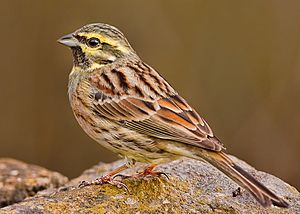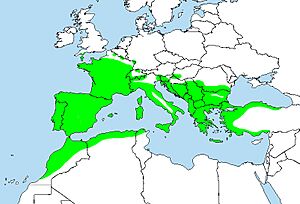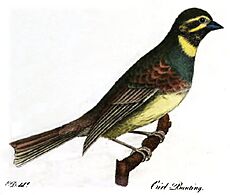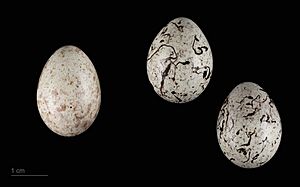Cirl bunting facts for kids
Quick facts for kids Cirl bunting |
|
|---|---|
 |
|
| Male Cirl Bunting | |
 |
|
| Female Cirl Bunting | |
| Conservation status | |
| Scientific classification | |
 |
|
| Where Cirl Buntings live (shown in green) |
The cirl bunting (pronounced SURL), also known as Emberiza cirlus, is a type of bird that belongs to the bunting family. These birds are often found in open areas with some bushes or trees, especially on sunny hillsides.
Cirl buntings live in southern Europe, on islands in the Mediterranean Sea, and in North Africa. They stay in these warmer places all year round and do not migrate (travel to different places for winter). In the 1800s, some cirl buntings were brought to New Zealand, and their population still lives there today.
Sadly, changes in farming methods have caused problems for this bird. In England, where they used to live in many southern areas, they are now mostly found in south Devon. The cirl bunting is even a special symbol for the village of Stokeinteignhead in Devon.
Contents
About the Cirl Bunting
What's in a Name?
The cirl bunting was first officially described by a Swedish scientist named Carl Linnaeus in 1766. He gave it the scientific name Emberiza cirlus. The name Emberiza comes from an old German word for a bunting. The word cirlus comes from an Italian name, cirlo, which means a type of bunting that makes a chirping sound.
How to Spot a Cirl Bunting
The cirl bunting looks a bit like a smaller yellowhammer bird. It's about 15.5 centimeters (about 6 inches) long, and its wings can spread out about 22 to 25.5 centimeters (8.5 to 10 inches). It has a thick beak, which is good for eating seeds.
- Males: The male cirl bunting is quite colorful! It has a bright yellow head with a black top (crown), a black stripe through its eye, and a black throat. It also has a green band across its chest, and the rest of its underside is yellow. Its back is brown with streaks.
- Females: Females look more like a yellowhammer. They have a streaky grey-brown rump (the lower back) and chestnut-colored shoulders.
The male cirl bunting's song is a fast, rattling sound. It sounds a bit like the end of a lesser whitethroat's song.
Where They Live and What They Like
Cirl buntings love farmland that has a mix of grassy fields and fields where crops are grown. They especially like areas with thick hedgerows (rows of bushes) and dense patches of bushes. They can even live in green areas within towns and cities, like in Rome.
These birds usually stay in one area. In summer, they might only travel about 250 meters (about 820 feet) from their nests to find food. In winter, they might go up to 2 kilometers (about 1.2 miles) to find leftover crop stubble (the bottom parts of plants left in the ground after harvest).
Cirl Bunting Life and Habits
Starting a Family
Cirl buntings begin to breed when they are one year old. They build their nests low to the ground, hidden in thick bushes like blackthorn, hawthorn, bramble, and gorse.
The breeding season lasts from April to mid-September. Most pairs have two groups of babies (called broods), but sometimes they have three. The female lays two to five eggs. These eggs have thin, hair-like markings, which are common for bunting eggs. Only the female bird sits on the eggs to keep them warm. They hatch about 12 to 13 days after the last egg is laid.
Both parents help care for and feed the young birds. The baby birds leave the nest after 11 to 13 days, but their parents continue to feed them for another two or three weeks.
What They Eat
In the summer, cirl buntings eat invertebrates (small creatures without backbones), such as grasshoppers and crickets. They feed these to their chicks.
In winter, they eat small seeds found in fields where crops were harvested (stubble), empty fields, or areas left unplanted. They also eat seeds from grain or hay that farmers feed to their animals. Cirl buntings often feed together in flocks during the winter months.
Cirl Buntings in England

A Brief History
A very small group of cirl buntings lives in South Devon, England, near a town called Kingsbridge. A famous bird expert named George Montagu first discovered them there in the early 1800s. It seems the birds first settled in Britain near Kingsbridge, and then spread across southern England during the 1800s.
However, from the 1930s onwards, their numbers began to shrink. By 1989, most of the cirl buntings in England were again found mainly near Kingsbridge.
Helping the Cirl Bunting
Thanks to special efforts, the cirl bunting population in England has grown a lot! Groups like Natural England and the RSPB (Royal Society for the Protection of Birds) work with landowners to help these birds.
Here are some ways they help:
- Leaving Stubble in Fields: Farmers leave leftover crop stalks (like from barley) in the fields over winter. They don't use fertiliser or pesticides, and they don't dig up the soil until the next spring. This allows the cirl buntings to eat spilled grain and seeds from weeds that grow there. This old farming practice helps the birds find food in winter.
- Keeping Grassy Areas: They keep areas of rough grassland and field edges, especially with clumpy grasses like cock's-foot. These areas provide a home for insects in winter, which then become food for the cirl buntings and their chicks.
- Planting Special Crops: Farmers plant special mixes of seeds, often with barley, that birds can easily find and eat.
- Delaying Insecticide Spraying: They wait as long as possible before spraying chemicals to kill insects. This makes sure there are enough insects for the birds to eat.
- Not Trimming Hedges: Hedges are left untrimmed for periods of time. This gives the birds safe places to build nests and find food.
Because of these efforts, the number of cirl bunting pairs in England grew from just 118 in 1989 to 700 in 2003! While their numbers have increased, they still mostly live in Devon.
Images for kids









